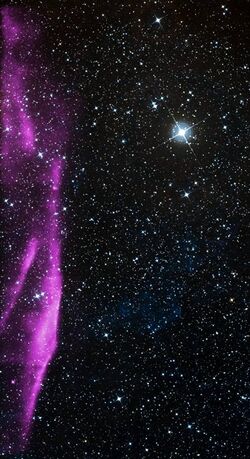Astronomy:RX J0852.0-4622
 | |
| Spectral class | SN |
|---|---|
| Date | 1998 |
| Constellation | Vela |
| Right ascension | 08h 52m |
| Declination | −46° 22′ |
| Epoch | J2000.0 |
| Galactic coordinates | 286.9460 +42.4568 (34" W, 10" S) |
| Distance | 700 ly |
| Remnant | ? |
| Notable features | Could be associated with PSR J0855-4644. central object in SNR RX J0852.0-4622 = AX J0851.9-4617. |
| Peak apparent magnitude | ? |
RX J0852.0-4622 (also known as G266.2−1.2) is a supernova remnant. The remnant is located in the southern sky in the constellation Vela ("sail"), and sits (in projection) inside the much larger and older Vela Supernova Remnant. For this reason, RX J0852.0-4622 is often referred to as Vela Junior.
It was found in 1998[1] when gamma ray emissions from the decay of 44Ti nuclei were discovered using the Imaging Compton Telescope (COMPTEL).
The distance to this object is controversial, but some scientists argue that the supernova remnant is only 650-700 light-years away,[1][2] and exploded comparatively recently (as seen from Earth), perhaps within the last 800 years. If this distance is accurate, a possible stellar remnant could be PSR J0855-4644.
If the remnant is indeed young and nearby, its corresponding supernova should have been visible from the Earth in about the year 1250. One difficulty with this interpretation is that there are no contemporary written reports of any supernova at that time or in that part of the sky.
Analysis of Antarctic ice cores suggest a supernova around the year 1070[3] which was not recorded by any contemporary astronomers. This supernova, at 46 degrees south, may have been too far south for observers in the northern hemisphere to have noticed it, especially if it obtained peak brightness during the northern summer. At this declination, the supernova would be invisible above about 45 degrees north, making it invisible to the majority of Europe.
The central compact object (CCO) was discovered in 2001.[4] In the initial Chandra X-ray image and deeper images thereafter, no pulsations were detected from the compact remnant, which is believed to be a neutron star.
References
- ↑ 1.0 1.1 Iyudin, A. F.; Schönfelder, V.; Bennett, K.; Bloemen, H.; Diehl, R.; Hermsen, W.; Lichti, G. G.; Van Der Meulen, R. D. et al. (1998). "Emission from 44Ti associated with a previously unknown Galactic supernova". Nature 396 (6707): 142–144. doi:10.1038/24106. Bibcode: 1998Natur.396..142I.
- ↑ Aschenbach, B. (1998). "Discovery of a young nearby supernova remnant". Nature 396 (6707): 141–142. doi:10.1038/24103. Bibcode: 1998Natur.396..141A. http://user.astro.columbia.edu/~jules/C3273_10/aschenbach.pdf.
- ↑ http://www.universetoday.com/26102/evidence-of-supernovae-found-in-ice-core-sample/
- ↑ Pavlov, G. G.; Sanwal, D.; Kiziltan, B.; Gairmire, G. P. (2001). "The Compact Central Object in the RX J0852.0−4622 Supernova Remnant". The Astrophysical Journal 559 (2): L131. doi:10.1086/323975. Bibcode: 2001ApJ...559L.131P.
External links
- Iyudin, A. F; Aschenbach, B; Becker, W; Dennerl, K; Haberl, F (2004). "XMM-Newton observations of the supernova remnant RX J0852.0-4622/GRO J0852-4642". Astronomy & Astrophysics 429: 225. doi:10.1051/0004-6361:20041779. Bibcode: 2005A&A...429..225I.
- "NAME Vela Jr SN". SIMBAD. Centre de données astronomiques de Strasbourg. http://simbad.u-strasbg.fr/simbad/sim-basic?Ident=NAME+Vela+Jr+SN.

